Review GSM phone Samsung P730
Standard lit:
- Handset
- Manual
- Charger
- Handsfree headset

After the release of Е700 model, Samsung produced a number of models of the top price segment; however, none of them became a model of the first priority. In the absence of such a "leading" phone, all other models serve merely to feed the attention of the consumers, although it is clear that the sales of these models would never be of a blockbuster character similar to that of Samsung E700. Among the indicated models, Samsung E800 with all its variations as well as Samsung P730 should be mentioned. The latter is the first company's phone to enter the GSM-market. This phone encompasses several note-worthy technologies: it is equipped with a megapixel camera, new rotating mechanism, MMS-card slot, and mp3 player. Besides, the great phone's display as well as the grand memory capacity should be grant attention. "What else is there to ask for a phone to become a bestseller?" would you ask. The answer is simple: the reality is more controversial than it seems to be.
The dimensions of the phone are typical for the ones with similar functions; Sharp GX30, for example, looks bigger. In some sense, the smooth lines on the phone's outer panel, take away the impression of the phone's bulkiness. The weight is 120 grams, which is not very typical for the current phones although is acceptable for the phones of this class. External antenna adds to the overall impression of largeness of the phone and is rather an obsolete element.


Those ones who use of Motorola MPx200,
Samsung V200,
P400 or
LG G7100 should come to grips with the phone's dimensions since they can be compared to the dimensions of their own phones. The phone fits well into the hand palm and can be opened with one hand. The peculiar feature of the phone is that it did not turn out to be a common clamshell since it is equipped with the rotating external display. This differs from the suggested models (from P400 for instance) because the rotating mechanism is located on the upper part of the phone and is circularly shaped. In the previous models, it was joining of the actual leafs.


Speaking functionally, the mechanism was to please those who wish opening the phone in various ways, which is achieved by means of a catch placed on the upper part in this particular model. When opened, the phone looks just like a classical clamshell of the kind. The slight tilting to the left switches on the camera mode, when tilting, the catch is automatically turned off. The rotation should be stopped here so that the internal screen becomes the external one. The mechanism is a novelty although the displays' rotation does not really make sense since the phone is already equipped with the external screen.


Since the mechanism was primarily meant for working with the camera, the detailed description of the rotating mechanism can be found in the review of the phone's camera.





Returning to the description of the phone, it should be noted that the mechanism is approximately one centimeter in height and raises over the keypad. Since the scroll key with the inserted "OK" button in it is also located here, the quality of the mediocre ergonomics becomes obvious. Although one can move around the menu using the scroll key (vertical shifts and using the side key), data has to be entered using the keypad. This constitutes one of the phone's disadvantages: users' fingertips have to "become acquitted" to switching in between the different levels of height, which leads to the overall feeling of fatigue after active work with the phone.


Blue edging of the service indicator around the scroll key looks very nice. The service indicator works at incoming calls and new messages. You can find here several LEDs that gradually turn on and off depending on the current operation. Besides, there can be found another standard lighting indicator located under the external screen; this second indicator is rather typical and backlighting color may be chosen.

A coupled volume key may be found on the left upper side of the phone, slightly above the IrDA (unfortunately, the functionality here is also mediocre). The interface connector is found on the bottom butt-end covered with rubber muffler attached to the frame case. The frame case of this model looks new and differs from the previous ones of the product range. The new battery charger looks more stylish and is now equipped with a charging indicator of two colors - the red one ("is in charge") and the green one ("charged").

The MMC card slot is located on the right side and is covered with a shutter. Another particularity of the phone is that you cannot completely insert the card into the slot-one end of it would be always showing over the frame case. Such construction implies the rejection of the mere thought of using the phone as an mp3 player with regular memory cards. The card is likely to fall out of the connector when the phone is carried in the pocket (although the phone is equipped with a blocking mechanism that clicks when the card fits in). It would be troublesome to carry the phone with an inserted card since the phone does not fit into the case and has to be placed into the outfit pockets (but never into the pants' pockets!) then. RS-MMC cards would serve as an alternative here. However, it is rather difficult to purchase them due to their shortage on the market though these are the cards to fit into the slot ideally.
There is no restriction on the cards' size that can be used in the phone; different cards of 256 Mb capacity from various manufacturers were tested. The speed of the data transmission to the card is great for all the phones-everything functions perfectly without any shortcomings.
The right side of the phone is equipped with a camera button and the headset connector with a sliding shutter located slightly above it (the headset connector is also onordinary).
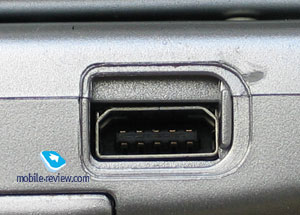
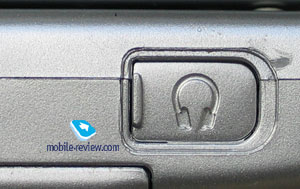
The phone's external screen with the resolution of 96x64 pixels is capable of reflecting up to 4096 colors. The display reads up to two text lines and two information bars at once. When exposed to the sunrays, data on the screen becomes almost invisible; the internal screen is recognized for the better quality in this case-the information can be read off it.

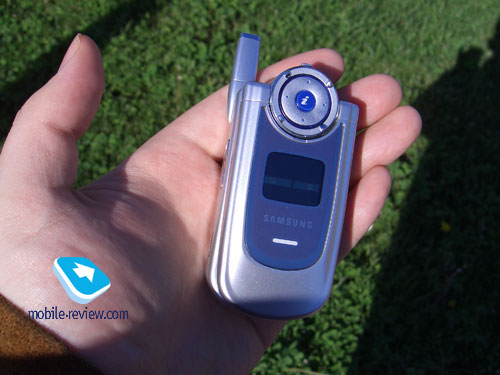
The internal screen is of 128x160 pixels resolution and thus can show up to seven text lines and up to three information bars. The display is 65K (TFT) and overrides in its quality the displays from other companies or a similar display of Samsung E800. When compared the picture on the display to the one on the screen of Sharp GX30 (262K), it becomes difficult to tell which one is better. Although the details of the Sharp picture are more distinct, the overall picture is not very bright. Actually, Samsung is distinct for the striking brightness of its picture. It would be fair to say that the screen of this model is presently one of the best.
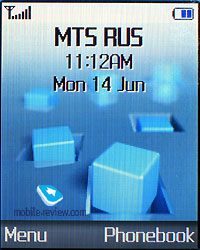
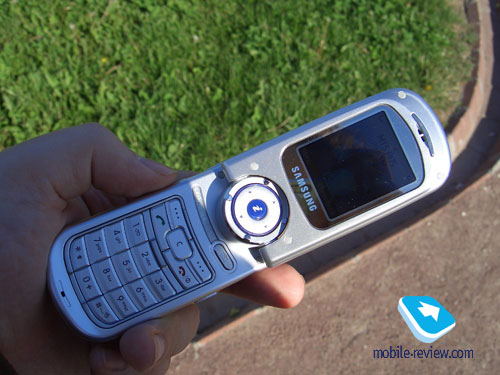
The keypad makes constitutes of a single block with a blue backlight of the buttons; the backlight is not apparent for all the keys. The keypad is rather comfortable; the keys are big and handy.
The Li-Ion battery of 1050 mAh is the last thing to be mentioned in this part of the review. At the producer's request, it is capable of providing up to 200 working hours in the stand-by mode and up to four working hours in the talking mode. The phone worked in the Moscow MTS network approximately three days in a row in case of about one hour of talk and up to 25 minutes of games (everyday use). The phone can work for more or less two days when used very actively and somewhat five days otherwise. It has to be acknowledged that the energy consumption was thoroughly reflected on and the phone can work for a truly long time considering the number of the offered functions. Full charging takes about two hours.
Menu
The organization of the menu is identical to that of the other Samsung phones although now the interface was ameliorated and became brighter with more colorful icons. The main menu and all the submenus are numbered; the shortcut number navigation is available. The user is welcome to choose one of the three types of viewing the menu: it can be film sequences (a big icon with a title), a list of the functions or three rows of icons. The submenus are arranged in regular lists.
 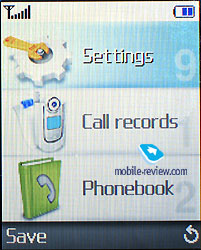
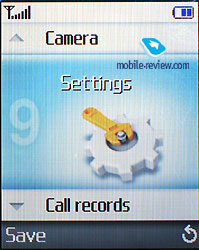 
 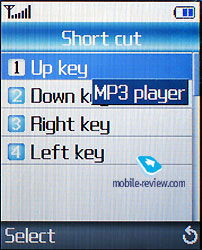
The internal memory capacity is about 50.5 MB, it may be used to store your your data. Here are photos,
video, mp3. Separate memory models for 1 MB are used for audio messages, MMS and games.
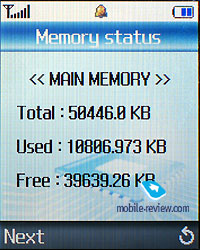
Phone book.
By pressing the right soft key, one can enter the phone book from the stand-by mode. You are immediately offered a list of the functions, "Name search" being the first one. The phone is capable of reflecting data from a SIM-card and the phone itself simultaneously. Here, if you are entering the phone numbers into the phone's memory, you are offered to record several numbers for one name at once (numbers such as that of the cell phone, home, business, fax, and others) along with the e-mail address, and the Internet address. Moreover, you can indicate right away a group of the phone subscribers this particular person belongs to. You can create up to ten in this phone naming each one upon your will. Special ring tones, pictures, and indicators for the SMS-messages can be created for some of the groups. Up to 2000 can be saved in the phone's memory.
 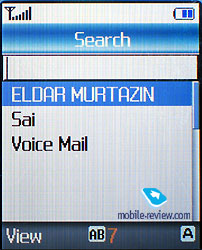
 
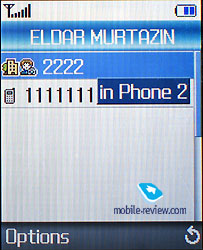
It is very convenient to view the data for the chosen name: you are offered a list with all the phone numbers so that you can choose an appropriate one. Speed dialing (limited to eight numbers) is available in the phone book's menu.
Now it is time to mention the new unique feature of the Samsung phones. That is to be a Photo Call function, which implies matching the person's picture with the phone number from the phone book. Samsung developed this function similarly to the way it was treated in the Motorola phones. You can assign a picture to any number, which means that every phone subscriber can have a matching photo for every one of his/her numbers. However, here you can use the photos only, and not the pictures. As different from the Motorola phones, you would not be able to assign a personal melody to the subscriber; it can be done only for the entire group.
Messages. The phone supports EMS standard as well as concatenated messages (up to 918 symbols). Consequently, a number of small pictures (22), an animation (24), and the option of attaching a melody to a message are offered. The phone's memory capacity is available for 200 messages not including the SIM-card.
 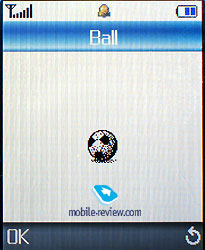
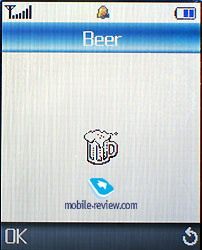 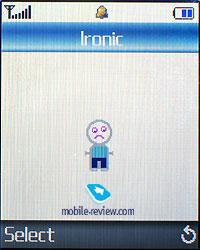
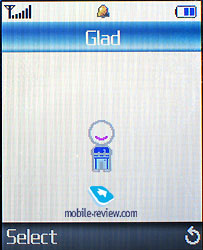
When you are typing in a message, you can choose to call up the submenu and change the language so that the message is written is several languages. Interesting enough, the predictable text entering is available for all the languages of the localized menus. For example, the Russian T9 dictionary is obtainable for the Russian menu.
MMS. As different to other models, multimedia messages are found as a separate function with a simpler interface. Several pages can be created; the size of a message is limited to 100 Kb for the to-be-sent message and to 45 Kb for the to-be-received messages. 1024 Kb of the memory are meant for the MMS.
Call lists. The function is rather standard: the list of missed, received, and accepted phone calls with the indicated date and time can be obtained; each list comprises of approximately 20 files. The call counters lack the total time although the separate times for made and received calls are available.
Sounds. The phone is equipped with decent 60-tones polyphony. Several ring modes are offered such as a simple ring tone, s simple vibration, or miscellaneous. Other settings are standard: this would be the choice of separate alarms for the SMS, MMS, setting of one-minute timer at the talking, or the working "silent" mode (which is either the vibrator or the complete silence).
Settings.
The welcoming greeting can be opted for in the phone, although the screen savers are more interesting. For example, one of the five-offered animations can be chosen as a wallpaper. You can also choose the font type when in the stand-by mode.
 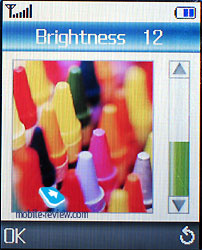
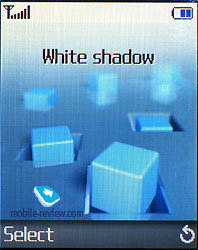 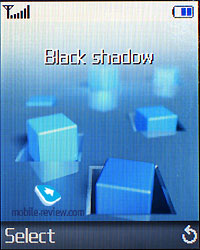
 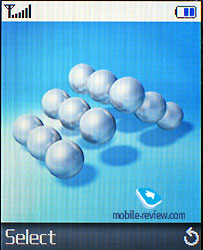
 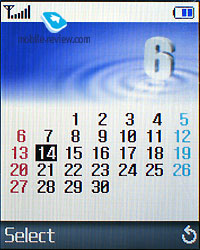
 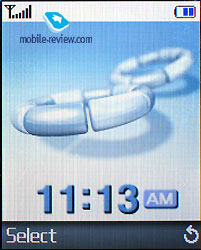
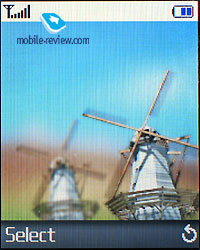 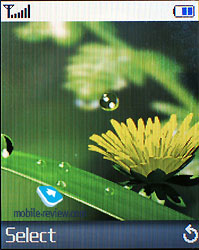
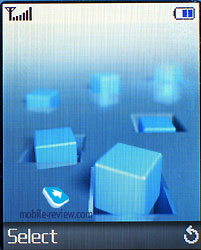
Curiously enough, the display backlight can be set for different periods of time and the range of choices is very large (from 15 seconds to ten minutes). Game fans would be interested in the longer time segment so that they would not have to play around with keys in order to activate the backlight.
Organizer.
You can enter a new memo into the organizer just at an instance. The memo can comprise up to 40 symbols. The different categories and types of the events are not available here. You just have to enter the event for the current day. It is possible to enter several events for a day; fast switch to a necessary date is provided. The calendar of the current month can be also viewed.
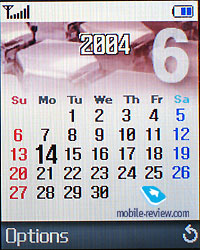 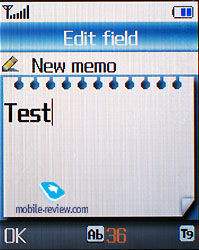
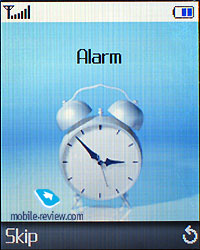 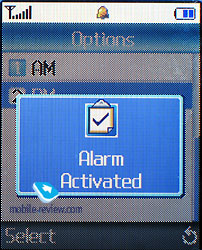
The function of the world time is available and does not stand out for any particularities. The same is true for a calculator and a currency converter
 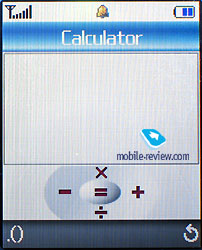

The alarm clock can be set for specific weekdays; the phone can be also switched on automatically. Then, the alarm clock will go off even if the phone is switched off.
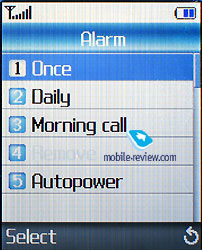 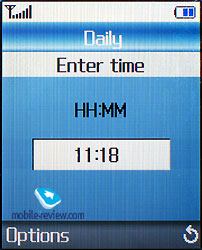
You can indicate the priority tasks on the list of things to do; everything is standard here.
 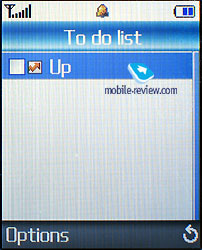
Network services. These services are responsible for the call forwarding, readdressing and so on; nothing outstanding. It should be noted that the phone is a tri-band and not a dual band as claimed in the official sources. One can opt for the third frequency (GSM 1900), which is typically handset.
Fun Box.
All the received pictures, images, videos, and melodies are to be found in the folders respectively named Sounds, Images, and Videos.
Three games-BubbleSmile (the beloved version of the "balls"), Fun2Linck (the logical game), and Mobile Chess are offered in the phone and cannot be deleted from the memory.
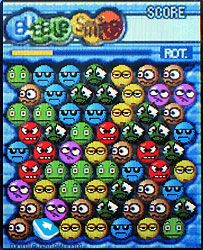
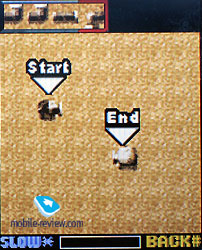
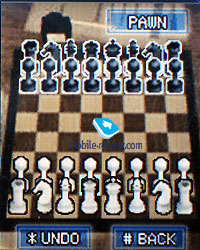
This is the first time when 3D games are offered in a Samsung phone. There are three of them in the phone-Metalion (the cosmic game when one flies and shoots off the enemies), Bomb (the "brick game" variation), and Zio Golf (a variant of the golf game). The games function very well and are fun to play. Due to the high quality of the display and the phone's processor, the details of the pictures are very distinct.
 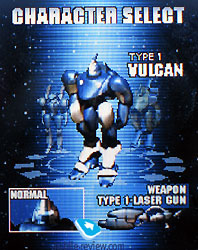
 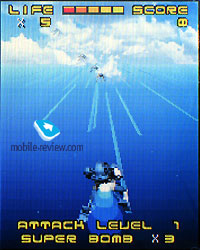
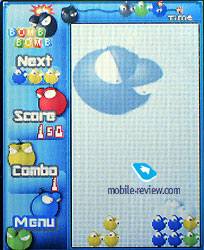 
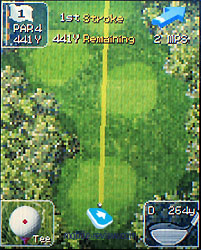
Camera.
The function is devoted a separated review.
WAP.
The wap-browser version 2.0 that allows viewing colorful images is located here. The phone supports GPRS (GPRS 4+2), which makes browsing very convenient.
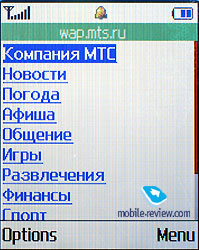
Applications. Rather a simple mp3 player with the "replay" function and the file organization according to the date and time is found here. You can listen to the player through the headphones only; the player can be activated only in one memory.
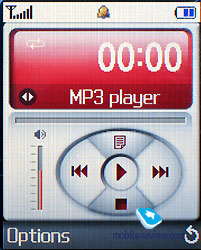 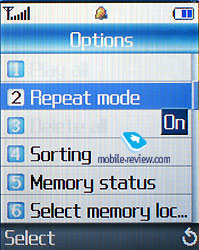
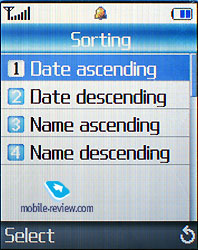
100 Kb of the phone's memory is meant for a dictaphone, which picks up the records of 30 seconds in length; only five records can be stored in the memory.
Impressions
The quality of connection does not greatly differ from that of other Samsung models-there are actually no problems here. The polyphony is of a great power and pleasing quality. The offered melodies' set is standard. One disadvantage here is that you cannot opt to have the mp3 melody as a ringtone.

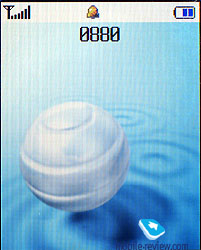
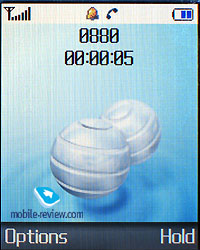
Among other phone's advantages, the RS-MMC slot fitting for the regular cards should be mentioned. However, a disadvantage is found here as well: the archives cannot be kept on the card since it is meant solemnly for the mp3, videos, and photos. The quality of the video records is rather high, which cannot be said about the mediocre pictures (similar to those of Nokia, Motorola, but worse than those of Sharp GX30).
The phone will enter the market at the beginning of July pricing around 550-600 USD. The functions offered in the phone lead to a relatively high price. The phone is a niche product and when the ergonomics are concerned, it does not look advantageous compared to other phones of the company. The phone is great for the quality of its display and polyphony, a significant memory capacity, and option of video recordings. The users interested in the listed functions and not concerned with the phone's form-factor, should definitely check out this model. Nevertheless, this phone was not meant to be a blockbuster and won't be.
Ring tone samples (mp3, 380 Kb)
Topic references:
Eldar Murtazin (eldar@mobile-review.com)
Translated by Maria Mitina (maria.mitina@mobile-review.com)
Published — 2 October 2004
Have something to add?! Write us... eldar@mobile-review.com
|















































































